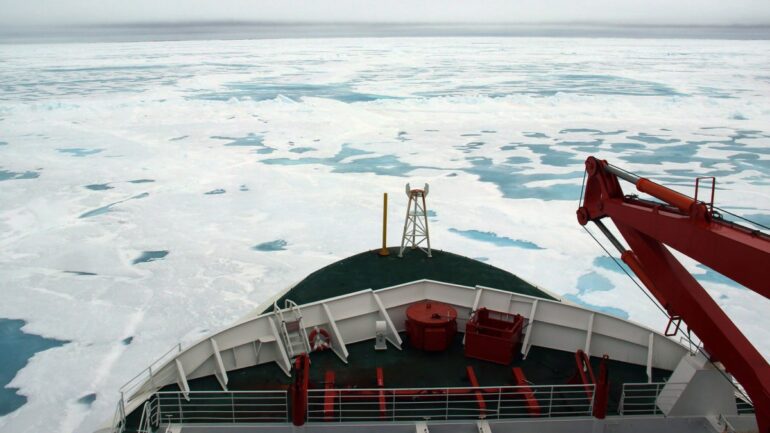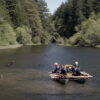When scientists discovered a hydrothermal vent site in the Arctic Ocean’s Aurora hydrothermal system in 2014, they did not immediately realize just how exciting their discovery was.
“Although finding any vent in the Arctic Ocean was a first, we figured what we had found was one of the least interesting kinds of vent sites that there are,” said Chris German, senior scientist with the Woods Hole Oceanographic Institution’s Department of Geology and Geophysics. “We came home from the expedition thinking, ‘OK, we found a site in the Arctic. That’s great, but if you take away the ice-cover, it is just another vent site.'”
However, after further analysis and a follow-on 2019 expedition to the remote site, German and other researchers now think this is a very significant finding. They believe that this vent—and others still to be located within the Arctic Ocean’s Gakkel Ridge rift-valley floor—could change our understanding of ultra-slow spreading mid-ocean ridges, substantially expand the estimates of valuable marine mineral deposits rich in copper and gold and serve as natural laboratories to help inform the search for extraterrestrial life.
“Our findings have implications for ultra-slow ridge cooling, global marine mineral distributions, and the diversity of geologic settings that can host abiotic organic synthesis–pertinent to the search for life beyond Earth,” according to the paper, “Volcanically hosted venting with indications of ultramafic influence at Aurora hydrothermal field on Gakkel Ridge,” published in Nature Communications.
“The single biggest part of what we may have discovered is a vent site beneath an ice-covered ocean that is also a great place to study organic synthesis relevant to the origin of life and the search for life beyond Earth,” said German, who is lead author of the paper. “The combination of studying the geology of the seafloor and the chemistry of the overlying water column is what gives us particular insights into this vent site and reveals that it has these special qualities.”
The vent site could be a natural laboratory to prepare for exploring the Saturnian moon of Enceladus, Jupiter’s moon Europa, and other Solar System bodies with subsurface oceans that could provide conditions of habitability for life, he said.
The advance in our understanding about subsurface minerals also is significant, according to German.
The findings about the vent site “suggest that hydrothermal mineral deposits that could be economically viable in the future—because of, for instance, the high levels of copper and gold present in the deposits—might be a lot more abundant along one-half of all the world’s ridge crests than we have previously appreciated,” he said.
“This is a class of vent sites that previously had been dismissed as unable to sustain the growth of large hydrothermal mineral deposits. Until now, scientists assumed that such small volcanic systems could not sustain hydrothermal circulation for long enough to grow such large mineral deposits.”
Regarding marine mining, German said, “As scientists, we feel that we that we should get this information out to decision makers, such as the International Seabed Authority, so that they can make informed decisions with a better understanding of the natural world.”
The Aurora hydrothermal system hosts active submarine venting with an extensive field of relict mineral deposits, associated with a neovolcanic mound located within the Gakkel Ridge rift-valley floor. However, deep-tow camera and sidescan surveys that researchers conducted show that the site is more than 100 meters across. That is unusually large for a volcanically hosted vent on a slow spreading ridge and is more comparable to tectonically hosted systems that require large heat fluxes over a long period of time to form, according to the paper.
The hydrothermal plume from Aurora exhibits much higher dissolved methane values, relative to manganese, than do typical basalt-hosted “black smoker” vents. Instead, the plume closely resembles plumes from high-temperature ultramafic-influenced vents at slow spreading ridges.
“We hypothesize that deep-penetrating fluid circulation may have sustained the prolonged venting evident at the Aurora hydrothermal field with a hydrothermal convection cell that can access ultramafic lithologies underlying anomalously thin ocean crust at this ultra-slow spreading ridge setting,” the paper notes. Pillow basalts observed in outcrops at the seafloor “may only represent a relatively thin veneer of oceanic crust while the hydrothermal convection cell accesses ultramafic lithologies beneath.”
Ultramafic rocks are primitive rocks from the Earth’s interior that are similar to the bulk composition of meteorites. Ultraslow spreading ridges such as the Gakkel Ridge rift-valley spread at 1centimeter (cm; about a half inch) per year; by comparison, North America and Europe are spreading apart more than twice as fast at 2.5 cm (one inch) per year while the Pacific Ocean seafloor is spreading even faster at 10–20 cm (4–8 inches) per year.
To journal article co-author Eoghan Reeves, the significance of the Aurora discovery is that it may soon add a crucial new data point on what is currently a very sparse chemical plot of these kinds of hot springs.
“The vast majority of black smokers visually confirmed on the seafloor—now numbering well over 700—mostly interact with basaltic or more silica-rich rock types. Even though heated seawater circulation in iron-rich mantle—ultramafic—rock is a central topic in ocean world astrobiology and origin-of-life research, we currently only have chemical compositions for less than a dozen hot springs influenced by such rocks on Earth’s seafloor, obscuring just how chemically diverse—or similar—these fluids could be, and what chemistries might still be hiding out there,” said Reeves, associate professor at the Department of Earth Science and the Centre for Deep Sea Research, University of Bergen.
“The few systems we currently know of emit fluids that differ widely from each other chemically, and they have transformed our understanding of what microbiological and geochemical processes occur in these kinds of systems. Aurora’s plume shares some chemical similarity with another known hot spring, but there is still much we have yet to learn about the newly discovered site. It will be very exciting in future to see if Aurora fits into the chemical plot that we know or expands it.”
Article co-author Vera Schlindwein said she is “intrigued by the high-temperature venting at Aurora.” The basalt mound “is at a weird location right where the seafloor drops to large depths of the magma-starved Lena Trough,” said Schlindwein, professor at the Alfred-Wegener-Institute Helmholtz Center for Polar and Marine Research. Lena Trough is the southern continuation of the Gakkel Ridge.
“Shallow ultramafic rocks seem natural at this location, but a heat and melt source sufficient to build the Aurora basalt mound and sustain high-temperature venting is more of a surprise. With their highly discontinuous melt supply, ultraslow spreading ridges could hold even more surprises in store as to the geological setting of vent fields.”
Reflecting on the findings, German said, “We continue to be surprised by how diverse and wonderful the seafloor is. Every time we go out and explore, we get surprised because we do not just find more of the same. Rather, we continue to find completely new things, different from everything we have seen before.”
More information:
Christopher R. German et al, Volcanically hosted venting with indications of ultramafic influence at Aurora hydrothermal field on Gakkel Ridge, Nature Communications (2022). DOI: 10.1038/s41467-022-34014-0
Provided by
Woods Hole Oceanographic Institution
Citation:
Arctic hydrothermal vent site could help in search for extraterrestrial life (2022, November 2)



